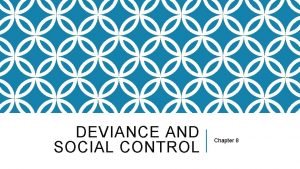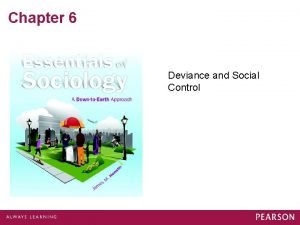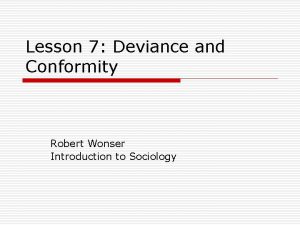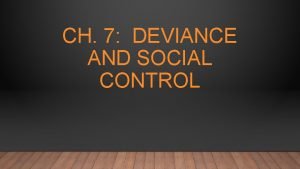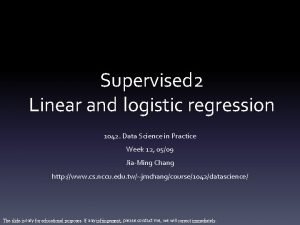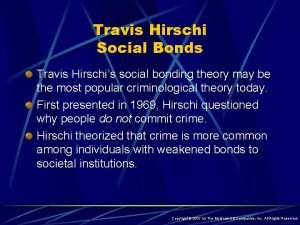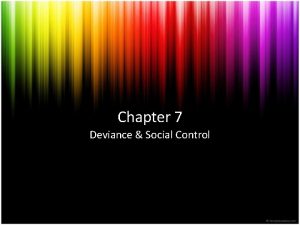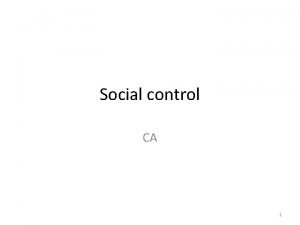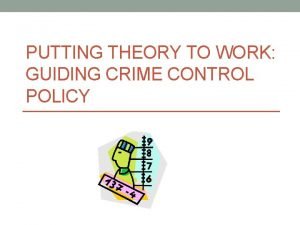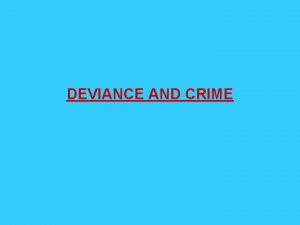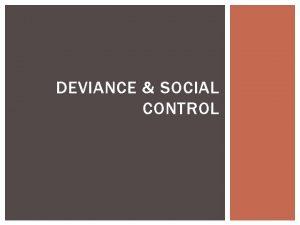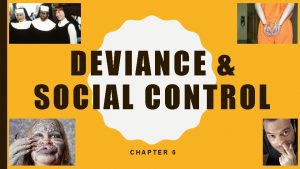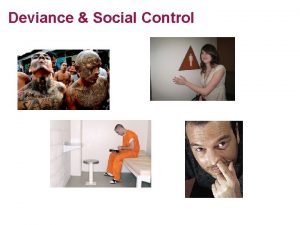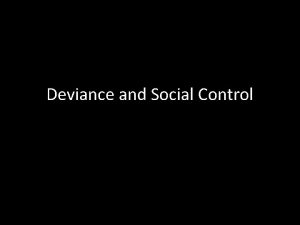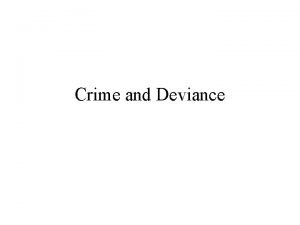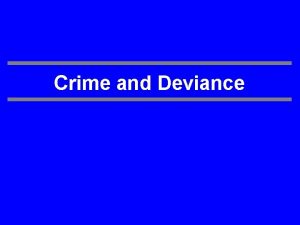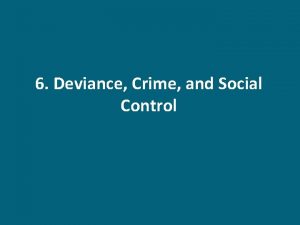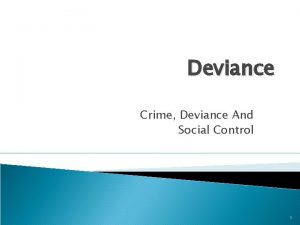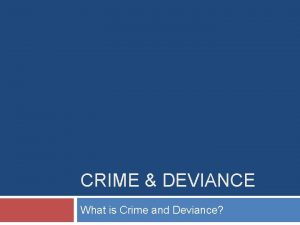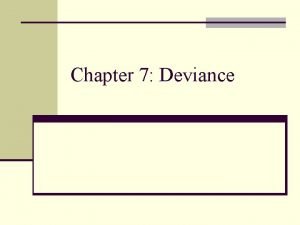Deviance Crime and Social Control Chapter 7 Deviance













- Slides: 13

Deviance, Crime and Social Control Chapter 7

Deviance and Crime Deviance is the violation of social norms. Crime is the violation of society’s formal laws.

Deviance Can be a trait, belief or behavior Is accompanied by a social stigma Varies across and within societies Varies across situations Perceptions can change over time Includes acts that range from picking one’s nose in public, belching loudly, to acts like suicide, alcoholism, lying, adult pornography

Types of Crime Street Crime—Violent and Property crimes Hate Crime—motivated by the offenders bias regarding ace, religion, ethnicity, sexual orientation, gender, or disability White-collar crime—illegal activities committed by high-status people in the course of their occupation Corporate Crimes-illegal acts committed by executives to benefit themselves and their companies Cybercrime—illegal activities that are conducted online Organized Crime—activities of individuals and groups that supply illegal goods and services for profit Victimless Crime—acts that violates laws but those involved don’t consider themselves victims

Theorist Explanation of Deviance

Controlling Deviance and Crime Social Control—the techniques and strategies that regulate people’s behavior in society Control Theory- purposes that deviant behavior decreases when people have strong social bonds with others Sanctions- rewards or punishments for obeying or violating a norm Crime control model-proposes that crime rates increase when offenders don’t fear apprehension or punishment.

Criminal Justice System Criminal justice system- government agencies that are charges with enforcing laws, judging offenders, and changing criminal behavior. Police—agency charged with enforcing society’s laws Sentencing-the penalty imposed by a judge or jury when someone had been found guilty of a crime (fine, probation, incarceration or death penalty) Incarceration-jail or prison Capital Punishment-the death penalty Rehabilitation-maintains that appropriate treatment can change offenders into productive, law-abiding citizens

Most Famous US Criminals Al Capone Infamous American crime czar Al “Scarface” Capone was once king of the Chicago rackets. A Prohibition-era gangster, he ruled a multimillion-dollar empire in the 1920 s that was fueled by illegal booze, gambling and prostitution. Capone is also suspected of being the mastermind behind the 1929 Saint Valentine’s Day Massacre in Lincoln Park that left seven of his enemies dead. Capone’s reign as ruler of Chicago’s gangland ended in 1931 when he pleaded guilty to tax evasion and prohibition charges. After serving seven years and six months in federal prison, which included a stay at Alcatraz, Capone was paroled on Nov. 16, 1939. By that time, however, he suffered from paresis derived from syphilis. Capone went into seclusion at an estate near Miami, Fla. , where he died of a stroke and pneumonia on Jan. 25, 1947.

Charles Manson was leader of the Manson Family, a quasi -commune that he formed in California in the late 1960 s. Manson believed in an impending apocalyptic race war, which he termed “Helter Skelter. ” He orchestrated a series of gruesome murders on consecutive nights in an effort to help precipitate the race war. In 1969, Manson and his followers were convicted in the slaying of actress Sharon Tate and several others. Initially sentenced to death, Manson’s sentence was later commuted to life in prison. Manson was denied parole for the 12 th time in April 2012. John Wayne Gacy was convicted of murdering 33 young men and boys between 1972 and 1978. Most of the bodies were found buried underneath the crawl space of his Chicago-area home. At the time of his arrest, Gacy claimed he was responsible for at least 45 murders. Gacy was given the nickname “The Killer Clown, ” because he sometimes adopted the persona of “Pogo the Clown” and participated in charity fundraising events. He was ultimately sentenced to death and executed at the Stateville

Ted Bundy In the 1970 s, Ted Bundy had a bright future in the Washington State Republican Party; instead, he became one of the most famous serial killers and necrophiliacs in U. S. history. He often deceived his victims, all women, into thinking that he was injured and in need of help before attacking them. In 1976, he was arrested for an attempted kidnapping, but while acting as his own lawyer, he escaped. He migrated to Florida, where he killed two women in a Florida State University sorority house and 12 -year-old Kimberly Diane Leach. He was convicted of those murders and, while on death row in 1989, he confessed to 50 other murders. The true total remains unknown. Bundy died in the electric chair at Raiford Prison in Starke, Fla. , on Jan. 24, 1989. Timothy Mc. Veigh A homegrown terrorist, Timothy Mc. Veigh detonated a truck bomb in front of the Alfred P. Murrah Federal Building in Oklahoma City on April 19, 1995. The attack, commonly referred to as the Oklahoma City bombing, claimed the lives of 168 people, including 19 children. A Gulf War veteran, Mc. Veigh was seeking revenge against the federal government for the 1993 siege of a compound belonging to the religious group Branch Davidians in Waco, Texas. The siege ended in the deaths of sect leader David Koresh and 75 of his followers. The bombing of the Murrah building took place on the twoyear anniversary of the Davidians’ deaths. Mc. Veigh was convicted of 11 federal offenses and was executed on June 11, 2001.

Jim Jones, the founder and leader of the Peoples Temple, fled California in 1974 with his followers and set up a compound in Guyana, which he dubbed Jonestown. Jones, a charismatic and disturbed individual, had become paranoid that the CIA and FBI were watching him. Jones ruled his community with an iron fist and did not permit anyone to leave. His actions made it back to officials in the U. S. and, on November 18, 1978, California Congressman Leo J. Ryan paid a visit to Jonestown. After touring the facility, Ryan left the compound with a number of defectors. Angered, Jones sent some of his men to the airstrip in Port Kaituma, where they gunned down Ryan and four others. Later that same day, 909 of Jones’ followers, 303 of which were children, died of apparent cyanide poisoning. Jones died from a gunshot wound to the head consistent with suicide. “We didn’t commit suicide; we committed an act of revolutionary suicide protesting the conditions of an inhumane world, ” Jones said in a 45 -minute audio recording that was made that day. The incident was, until Sept. 11, 2001, the single greatest loss of American civilian life in a non-natural disaster. Wayne Williams was tried, convicted, and sentenced to life imprisonment in 1982 for killing two adult men. After his conviction the Atlanta Police announced that Williams was responsible for at least 23 of the 29 Atlanta murders of 1979 -1981, also called the “Atlanta Child Murders” Williams currently still maintains his innocence.


 Chapter 7 deviance crime and social control
Chapter 7 deviance crime and social control Deviants chapter 8
Deviants chapter 8 Chapter 6 deviance and social control
Chapter 6 deviance and social control Deviance avowal
Deviance avowal Social control examples
Social control examples Null deviance vs residual deviance
Null deviance vs residual deviance Crime and deviance sociology revision
Crime and deviance sociology revision Difference between crime and deviance
Difference between crime and deviance Crime and deviance definition
Crime and deviance definition Marxism crime and deviance
Marxism crime and deviance Social bonds theory
Social bonds theory A repetition of or return to criminal behavior is ?
A repetition of or return to criminal behavior is ? What is social control
What is social control Crime control policies
Crime control policies

